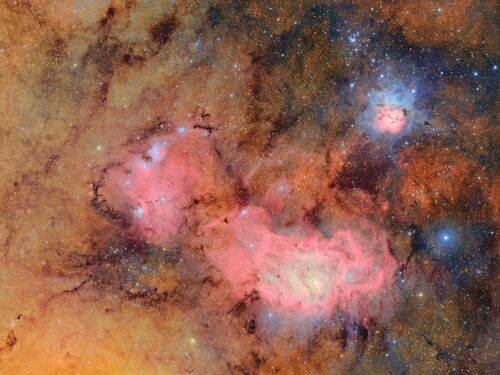First Images from Vera C. Rubin Observatory Debut at National Academy of Sciences
Feature Story
By Josh Blatt
Last update June 24, 2025
Credit: NSF–DOE Vera C. Rubin Observatory
Project scientists displayed an extraordinary set of ultra-high-definition images and videos for the first time — showcasing both the exploratory and precision capabilities of the recently constructed Vera C. Rubin Observatory. The “First Look” event, held yesterday at the National Academy of Sciences building in Washington, D.C., previewed panoramic views of space, detailed images of nebulae, and 2,100 newly discovered asteroids.
The Rubin Observatory, a joint venture of the U.S. Department of Energy and the National Science Foundation, was built on a mountain in northern Chile to take advantage of clear skies and minimal light pollution. The observatory will conduct a 10-year survey by scanning the Southern Hemisphere’s entire night sky every three to four days, presenting an unprecedented view of the universe and a trove of astronomical and cosmological data that researchers around the world will make use of.
This first-of-a-kind observatory, which contains the world’s largest digital camera, will help expand our understanding of the universe, chronicle its evolution, and explore the mysteries of dark energy and dark matter. The facility was recommended in the National Academies’ 2010 decadal survey.
“It is very satisfying to see the recommendation from the National Academies’ decadal come to fruition through the hard work of the scientists and technologists, with federal funding for science,” said Arul Mozhi, acting director of the Space Studies Board and Board on Physics and Astronomy at the National Academies. “The Vera C. Rubin Observatory’s First Look images and discoveries are awe inspiring and are sure to continue inspiring current and future scientists for a long time.”
The observatory’s namesake, Vera C. Rubin, was a member of the National Academy of Sciences and a pioneering astronomer whose research and observations uncovered the clearest evidence of the existence of dark matter.
For additional information and images, visit https://rubinobservatory.org/news/first-imagery-rubin.
It is very satisfying to see the recommendation from the National Academies’ decadal come to fruition through the hard work of the scientists and technologists, with federal funding for science
For additional information and images, visit:




